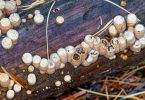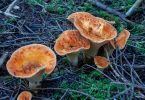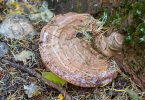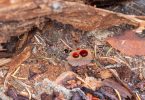Target audience
Teresa Marone and Drew Parker wrote, Mushrooms of the Northwest, to inform beginners how to identify mushrooms using visual characteristics. Mushroom hunters searching the Pacific Northwest states of Washington, Oregon and Idaho are the audience.
Publication layout
Adventure Publications produced the 296 page book released in 2019. It is definitely pocket sized measuring 4.25″ x 5″. Over 400 common mushrooms of the region are introduced to the reader. Images, ranging from 1″ x 1″ to book size, dominate this field guide. The first 17 pages alone have 54 photos. This dovetails with the authors purpose educating the beginning mushroom hunter: “how to look at a mushroom” (author emphasis).
Introduction
The authors maintain no special equipment outside a hand lens is necessary to identify the species outlined. They briefly recommend using a digital camera to capture mushroom images from the field for further study at home. Smartly they state the standard caveat for mushroom identification: weather plays a large part in what a mushroom looks like during different stages of growth. There are a series of three photos illustrating how a mushroom changes in size and shape over just four days, excellent visual for beginners. Habitat; climate; mushroom structure, function and basic categories described with text and images in the first 20 pages. This connects with the usual spate of technical terms like umbo or viscid. Edibility is also introduced as a major focus of this book.
Species accounts
After the introductory material, fifty pages accentuate the ten best eating and ten most toxic mushrooms of the Pacific Northwest. Each species account organized over two facing pages with bolded headings of: brief overview, habitat, description (includes similar species), spore print color, season of growth, how to distinguish and notes. Usually the text is on the left facing page and accompanying photos on the right. The colored photos are sharp and highlight features critical for identification. The ten categories of mushrooms (called forms in other books, e.g. cup, spherical mushrooms) are color coded for fast reference. This is very handy for beginners who can only initially browse by size and shape.
Summary
Another mushroom reference estimates there are 5,000+ plus fungi species in the Pacific Northwest. No one publication covers it all. That is reason enough to acquire this book for your library. I have noted several species to look for in the coming year after thumbing through the pages. No guarantees, but the information has me on track for future success. Happy shrooming!






